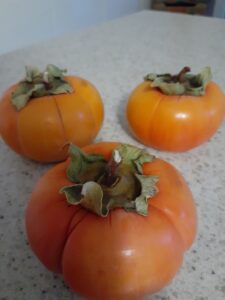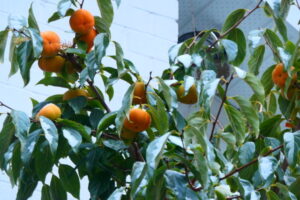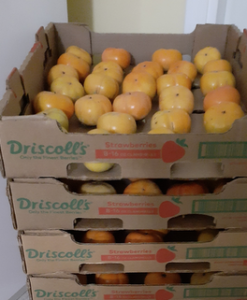Fuyu Japanese Persimmon Tree
Diospuros kaki “Fujy”
Rosina T. Schmidt
 The Fuyu Persimmon Tree will grow best in any well-drained garden soil, in Zone 7 to 10, as long as it is in full sun. No special pruning is necessary, but it can be trimmed to size if needed. It’s moderately drought resistant and usually free of both pests and diseases. It is a deciduous tree with a spreading crown clothed in glossy dark green leaves. It can reach a height of 6m – 9m (20’-30’) and will bear honey-sweet orange fruit for years and years.
The Fuyu Persimmon Tree will grow best in any well-drained garden soil, in Zone 7 to 10, as long as it is in full sun. No special pruning is necessary, but it can be trimmed to size if needed. It’s moderately drought resistant and usually free of both pests and diseases. It is a deciduous tree with a spreading crown clothed in glossy dark green leaves. It can reach a height of 6m – 9m (20’-30’) and will bear honey-sweet orange fruit for years and years.
Unlike other Persimmon trees, this one is of non-astringent variety, and it is self-pollinating, therefore will not have any seeds. Fuyu is the best variety for eating while still firm, with low tannin, so it tastes good without completely ripening.
On Vancouver Island, the fruit will not ripen fully on the tree so it should be picked before the arrival of the big storms, towards the end of November. To fully ripen keep the Persimmon for a few weeks in a warm place.
One Persimmon fruit – ca. 168 – grams contains:
Calories: 118
Carbs: 31 grams
Protein: 1 gram
Fiber: 6 grams
Fat: 0.3 gram
Vitamin A: 55% of the RDI
Vitamin C: 22% of the RDI
Vitamin E: 6% of the RDI
Vitamin B6 (pyridoxine): 8% of the RDI
Potassium: 8% of the RDI
Copper: 9% of the RDI
Manganese: 30% of the RDI
Note: it’s wight loss friendly food. The leaves of the Persimmon tree are high in vitamin C, tannins and fiber, as well as a common ingredient in therapeutic herbal teas.
19th Dec. 2022



 Meetings are held at 7:30pm on the second Thursday of each month from September through May at Beban Park, 2300 Bowen Road, Nanaimo, BC
Meetings are held at 7:30pm on the second Thursday of each month from September through May at Beban Park, 2300 Bowen Road, Nanaimo, BC